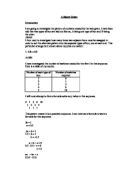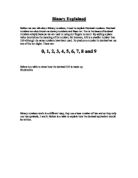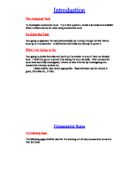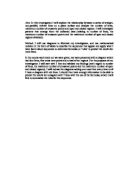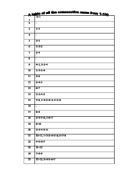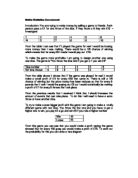Fraction Differences
Fraction Differences First Sequence To begin with I looked at the first sequence of fractions to discover the formula that explained it. As all the numerators were 1 I looked at the denominators. As these all increased by 1 every time, I figured that the formula was simply as the denominators corresponded to the implied first line as shown in this table below: nth number 2 3 4 5 6 7 8 Denominators 2 3 4 5 6 7 8 I shall call this Formula 1 (F1) for easy reference. Second Sequence Again I decided to discount the numerator as it was 1, and I decided to concentrate on the differences between the denominators rather than the 'fractions'. So I am looking for a formula that will explain the sequence: 2, 6, 12, 20, 30. First of all though I decided to extend the sequence in order to have a broader range to work with. I used a calculator to work out the following denominators finding the difference between and , and all the way up to I set the differences out in a table to try to find the pattern: nth number 2 3 4 5 6 7 8 9 Sequence 2 6 2 20 30 42 56 72 90 First Difference 4 6 8 0 2 4 6 8 Second Difference 2 2 2 2 2 2 2 2 As there was a constant difference of 2 I believed that the formula would include n². I applied this to the first number in the sequence '2'. So n² = (1 x 1 = 1). To get the first number of
A baker's dozen
A Bakers Dozen Introduction I am going to investigate the pattern of numbers created by the task given. I have been told that two types of bun are laid out like so, A being one type of bun and B being the other: ABAB I then need to investigate how many times two adjacent buns must be swapped in order to sort the alternate pattern into two separate types of bun, one at each end. This particular arrangement shown above requires one switch: . AB-AB AABB I have investigated the number of switches needed for the first 5 in this sequence. Here is a table of my results: Number of each type of bun Number of switches required 0 2 3 3 4 6 5 0 I will now attempt to find a formula solve any value in this sequence. 0 1 3 6 10 1 2 3 4 1 1 1 This pattern means it is a quadratic sequence. I can now use a formula to work a formula for this sequence. 2a = 1 a = 0.5 3a + b = 1 .5 + b = 1 b = -0.5 a + b + c = 0 0.5 - 0.5 + c = 0 c = 0 an + bn + c 0.5n2 - 0.5n I have now found a formula which can be used to work out the number of switches required for any number of buns. I will now test the formula to see if it is correct. I will test the formula with the number 3. The outcome according to my table should be 3. 0.5 * 32 - 0.5 * 3 = 3 I will now prove my formula is correct using induction. In order to do this I will have to show two
Binary Explained.
Binary Explained Before we can talk about Binary numbers, I need to explain Decimal numbers. Decimal numbers are also known as denary numbers and Base ten. Ten is the bases of decimal numbers simply because we are used to using our fingers to count. By adding a place value determines the meaning of the number, for instance, 192 is a smaller number than 219 although the same numbers have been used. To produce a number in decimal we use one of the ten digits. These are: 0, 1, 2, 3, 4, 5, 6, 7, 8 and 9 Below is a table to show how the decimal 235 is made up. Hundredths Binary numbers work in a different way, they use a base number of two and so they only use two symbols, 1 and 0. Below is a table to explain how the decimal equivalent would be written. This is how binary works. Because the binary system has a base of two, this means that each place number is a power of two. The table below shows the system. Table 1 If we look at the table and take the furthest column to the right and work our way the left, we see that: 2 to the power of 0 is = 1 2 to the power of 1 is = 2 (2x1 = 2) 2 to the power of 2 is = 4 (2x2 = 4) 2 to the power of 3 is = 8 (2x2x2 = 8) 2 to the power of 4 is = 16 (2x2x2x2 = 16) 2 to the power of 5 is = 32 (2x2x2x2x2 = 32) .......and so on. Now that the table is done we can start converting from binary numbers to
To investigate consecutive sums. Try to find a pattern, devise a formulae and establish which numbers cannot be made using consecutive sums.
Introduction The Assigned Task To investigate consecutive sums. Try to find a pattern, devise a formulae and establish which numbers cannot be made using consecutive sums. To Solve the Task I am going to approach the task systematically, by running through the first twenty sums up to 5 consecutive. I shall devise a formulae and attempt to prove it. What I am Going to Do I am going to devise formulae and work out the answer to a sum I have not already done. I shall then go on to prove it by adding the sum manually. After consecutive sums have been fully investigated, I intend to take it further by investigating into consecutive minuses, squares etc. Tables shall be used where appropriate. Essential ideas may be marked in green, formulae etc., in blue. Consecutive Sums The Following Pages The following pages shall be used for the working out of many consecutive sums and their formulae. The formula for this is 2n-1 Where n is the tern. (All ready a pattern of +2 is clearly visible) I am now going to prove this theory. 8+9=17 2n-1 2x9-1=17 I will also use a sum I have not previously worked out. 65+66=131 2n-1 2x66-1=131 0 + = + 2 = 3 2 + 3 = 5 3 + 4 = 7 4 + 5 = 9 5 + 6 = 1 6 + 7 = 3 7 + 8 = 5 8 + 9 = 7 9 + 0 = 9 0 + 1 = 21 1 + 2 = 23 2 + 3 = 25 3 + 4 = 27 4 + 5 = 29 5 + 6 = 31
In this investigation I will explore the relationship between a series of straight, non-parallel, infinite lines on a plane surface and analyze the number of lines, maximum number of crossover points and open and closed regions.
Aim: In this investigation I will explore the relationship between a series of straight, non-parallel, infinite lines on a plane surface and analyze the number of lines, maximum number of crossover points and open and closed regions. I will investigate patterns that emerge from the collected data (relating to number of lines, the maximum number of crossover points and the maximum number of open and closed regions obtained). Method: I will use diagrams to illustrate my investigation, and use mathematical notation in the form of tables to describe the sequences that appear and apply what I have learnt about sequences to determine formulas or 'rules' to predict the results for more lines. In the course work hand out we were given, we were presented with a diagram which had four lines, five cross-over points and a total of ten regions. For the purposes of my investigation I will start with 1 line and tabulate my findings (with regard to number of lines, the maximum number of crossover points and the maximum number of open and closed regions). I will redraw the diagrams adding one more line every time until I have a diagram with six lines. I should then have enough information to be able to predict the results for a diagram with 7 lines with the use of the formulae, which I will find to summarise the rules for the sequences. Diagram 1: 1 Line (open regions are depicted with
This coursework will be to investigate to see how many squares would be needed to make any cross-shape build up in this way.
Introduction The figure below shows a dark cross-shape that has been surrounded by white squares to create a bigger cross- shape: The bigger cross- shape consists of 25 small squares in total. The next cross- shape is always made by surrounding the previous cross-shape with small squares. This coursework will be to investigate to see how many squares would be needed to make any cross-shape build up in this way. Method First of all I'm going to work out a sequence which consists of a formula. Then I will draw a maximum of six cross-shapes adding on to each sequence, at the end I will produce one extra to testify the formula. After creating two tables to work out the first and second differences between the number of squares, I'll use those to find the values of a , b and c. Table 1 Shape Number 2 3 4 5 6 Number of Squares 5 3 25 41 61 st Difference 4 8 2 6 20 24 2nd Difference 4 4 4 4 4 4 No of squares: 1 5 13 25 41 61 st Diff: 4 8 12 16 20 2nd Diff: 4 4 4 4 To find the 1st and 2nd difference, I used a table and then the diagram above to check if I was right about my suggested answers. First of all, for the 1st
Number Sums Investigations
0+1 2 - 3 +2 4 - 5 2+3 6 +2+3 7 3+4 8 - 9 4+5, 2+3+4 0 +2+3+4 1 5+6 2 3+4+5 3 6+7 4 2+3+4+5 5 7+8, 1+2+3+4+5, 4+5+6 6 - 7 8+9 8 3+4+5+6, 5+6+7 9 9+10 20 2+3+4+5+6 21 0+11, 1+2+3+4+5+6, 6+7+8 22 4+5+6+7 23 1+12 24 7+8+9 25 2+13, 3+4+5+6+7 26 5+6+7+8 27 3+14, 2+3+4+5+6+7, 8+9+10 28 +2+3+4+5+6+7 29 4+15 30 4+5+6+7+8, 6+7+8+9, 9+10+11 31 5+16 32 - 33 6+17, 3+4+5+6+7+8, 10+11+12 34 7+8+9+10 35 7+18, 2+3+4+5+6+7+8, 5+6+7+8+9 36 1+12+13 37 8+19 38 8+9+10+11 39 9+20, 12+13+14, 4+5+6+7+8+9 40 6+7+8+9+10 41 20+21 42 3+4+5+6+7+8+9, 9+10+11+12, 13+14+15 43 21+22 44 2+3+4+5+6+7+8+9 45 22+23, 1+2+3+4+5+6+7+8+9, 5+6+7+8+9+10, 7+8+9+10+11, 14+15+16 46 0+11+12+13 47 23+24 48 5+16+17 49 24+25, 4+5+6+7+8+9+10 50 8+9+10+11+12, 11+12+13+14 51 25+26, 6+7+8+9+10+11, 16+17+18 52 3+4+5+6+7+8+9+10 53 26+27 54 2+13+14+15, 2+3+4+5+6+7+8+9+10, 17+18+19 55 27+28, 1+2+3+4+5+6+7+8+9+10, 9+10+11+12+13 56 5+6+7+8+9+10+11 57 28+29, 7+8+9+10+11+12, 18+19+20 58 3+14+15+16 59 29+30 60 4+5+6+7+8+9+10+11, 10+11+12+13+14, 19+20+21 61 30+31 62 4+15+16+17 63 31+32, 3+4+5+6+7+8+9+10+11, 6+7+8+9+10+11+12, 8+9+10+11+12+13, 20+21+22 64 - 65 32+33, 2+3+4+5+6+7+8+9+10+11, 11+12+13+14+15 66 5+16+17+18, 1+2+3+4+5+6+7+8+9+10+11, 21+22+23 67 33+34 68 5+6+7+8+9+10+11+12 69 34+35,
How does the use of numbers, statistics, graphs, and other quantitative instruments affect perceptions of the validity of knowledge claims in the human sciences?
How does the use of numbers, statistics, graphs, and other quantitative instruments affect perceptions of the validity of knowledge claims in the human sciences? During the last centuries people saw that experiments helped answer many questions about nature. Scientists were able to prove pattern and theories related to nature. Experiments became an essential factor for science because science is based on facts and in order to prove these facts to be true scientists know that by having experiments they are able to prove their theories and patterns of nature. Since humans are part of nature also, experiments can be done on us to show certain patterns of behaviours or maybe theories about our behaviour or about human nature. These studies on the human race are divided into many categories mainly called human sciences. These studies are called sciences because the use of numbers in collecting data and analysing them are essential to prove certain events. In todays society numbers became really important because it is an element that is essential in our life, starting from the money that we use to buy our daily needs to knowing how to count. Whenever humans encounter numbers in magazines they tend to believein them. Any quantitative instrument is believed in todays society because it is known that most of the quantitative instruments that are available are very precise. Precision
Maths Statistics Dice Investigation
Maths Statistics Coursework Introduction: You are trying to make money by selling a game to friends. Each person pays a £1 for one throw of the dice. If they throw a 6 they win £10 - Investigate 2 3 4 5 6 4 5 7 6 8 0 From the table I can see that if I played the game for real I would be loosing more money than I was making. There would be a 1/6 chance of winning which means that for every £6 I made I would pay out £10. To make the game more profitable I am going to design another one using one dice. The game is "You throw the dice and if you get a 1 you win £5" Dice number 2 3 4 5 6 No' time thrown 9 8 8 9 9 7 From the table above it shows that if the game was played for real it would make a small profit of £5 for every £50 that came in. There is still a 1/6 chance of winning but the prize money has been reduces so that for every 6 pounds that I took I would be paying out £5 so I would statistically be making a profit of £1 for every 6 throws that took place From the previous results that I received I think that I should increase the amount of events that can take place. To do this I will need to have a extra throw or have another dice. To try to make a even bigger profit with this game I am going to make a totally different game with two dice. You throw the first one and you have to get a higher one to
Transforming numbers
TRANSFORMING NUMBERS Name: Waseem Ahmed Course: PGCE Mathematics Question a › a + 2b where a,b are whole numbers b a + b › 3 › 7 › 17 ›....... 2 5 12 Investigate transformations of this kind Problem Statement This problem involves fractions and the aim is to investigate how these numbers can be transformed to the next number in the sequence. How will I go about investigating this problem? First I will like to know where this sequence leads me. From this I will get a better idea of approaching the problem. Approach Using excel spreadsheet, starting with numerator and denominator being equal, ie a=1 and b=1. I found that the sequence of the transformation eventually converging to the square root of 2. a equal to b (a=b=1) Sequence Sequence Table 1 of of a=b=1 Numerator Denominator Result 1 3 2 .5 7 5 .4 7 2 .4166667 41 29 .41337931 99 70 .4142857 239 69 .4142012 577 408 .4142132 393 985 .4142136 3363 2378 .4142136 From table 1, it was noticed that the sequence converges towards V2. I wanted to investigate what happens if a and b have different values and are not equal to each other. Again I used excel to develop the



